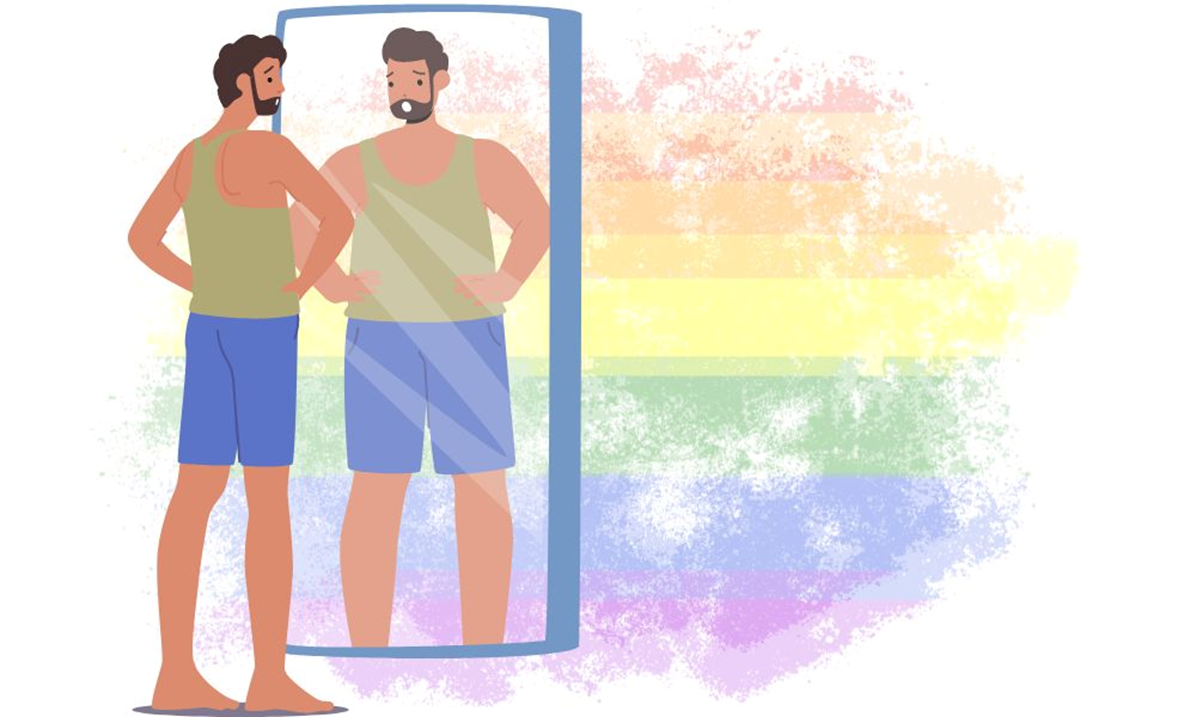
Addressing Concerns Related to Body Image, Acceptance, And Self-worth in The LGBTQIA+ Community

Understanding Self Acceptance -
Self-acceptance is the act of embracing your attributes, whether mental or physical and positive or negative, as they are. Learning to accept oneself becomes more challenging when there is little to no acceptance outside. When you experience something that is not talked about, or perhaps introduced to you as “abnormal”, such as identifying as homosexual, bisexual, trans, or queer/questioning, for example, seeking acceptance within is where the tumultuous journey starts. In this journey, acceptance of one’s appearance and physical attributes is also important.
The body may largely be one of the first things we come to associate ourselves with. What happens when you don’t associate with your body itself? Or, what happens if you associate too much with it? What if you don't accept the way it is? This is where body image comes into play. Body image is the mental picture one forms of one’s body as a whole. This includes the physical characteristics and own attitudes about them. They’re not always healthy and sometimes distressing.
Where do these attitudes come from? We learn them from the environment as children- from cartoons, comics, books, movies, and comments about bodies from others. This learning may be explicit or in more subtle ways. As time goes on and experiences happen, one’s beliefs may strengthen. Not everyone is comfortable with how their body looks- complaints about one’s nose, jaw, arms, or thighs. When we put further aspects of gender and sexuality, societal structures and norms into the mix of the experience, it’s a whole different ball game. Comments about the body since childhood make one more aware and vigilant of one's own body, even before one is made aware of their gender and sexuality.
All these “shoulds” of the acceptable way to look and make it heavily difficult to look beyond. The acceptance that people identifying themselves as queer have in the society, although largely varying, is yet to be complete. The experience of living daily life may be different for those identifying themselves as heterosexual or a cis-gender person- those non-compliant to the ‘preferred sexual orientation’. A queer person may have to go through “self-acceptance” on several different levels. Be it acceptance of their bodies, their sexuality, their gender, or seeking to be accepted in the outside world.
As a thought about our bodies, a philosophy that has been coming up in recent years, is one of body neutrality”. It comes in response to the movement on ‘body positivity’. It gives a good outlet to have more neutral thoughts about one’s body instead of pushing the “I love my body no matter what” mantra. To a lot of people, body positivity meant shame about feeling ashamed of their bodies. Body neutrality, however, talks about it being okay to not love your body. Some have described the journey as moving from discomfort to tolerance to acceptance and then to love, building resilience throughout the journey. It talks about doing away with sizeism and the prevalence of the “perfect body” in society.
The regular stereotypes apply to those who identify as queer, but along with that, there are certain additional criteria. For instance, one may have to appear to be “genderless” or look androgynous to be considered “non-binary enough”, which in turn goes hand-in-hand with being skinny. Body type pressures may have more significance for those in the LGBTQIA+ community as it may be a matter of life and death. Fitting into societal standards may be a requirement for a safe living.
When it comes to societal structures, some changes may help while on a personal level, one may deal with such a situation differently. The gay community, for instance, uses different names for classifying people into body types: Twinks, bears, otters, wolves, jocks – it feels as though there is a long list of terms for people based on the size and shape (and hairiness) of their bodies. And it appears that some of these body types too are more desirable and given a different status. To not fit into a minority community can be a distressing experience and hence fitting into a body type may be the easier route. To navigate this space, there are mental health care services in India to support anyone struggling, and there are also some things one can do as an individual.
Dealing with body image and self-acceptance is largely to do with requiring one’s thoughts. How does one go through this process?
- Awareness:
- Triggers:
- Thought:
- Origin:
- Questioning:
- Mindfulness:
- Reframe:
- Social Media:
- Behaviours:
An initial step would be that of awareness. One would start to look out for and label their emotions as they come in. What do you feel when you think about your body?
When do these feelings come in? This helps us answer what the triggers are for these thoughts. Was it a comment by someone, a poster, an advertisement, a reel, or looking at oneself in the mirror?
What did I tell myself? Did I say I’m not pretty? Did I say my nose is too big? Did I say my jaw is not defined enough?
Where is this thought coming from? Have I been told of this? How did I reach this conclusion?
Questioning the thought and its validity. Finding explanations to say one way to look is better than the other.
Catching oneself when they have a thought regarding another person’s body too.
Accepting one’s own body the way it is. Reframing the thought to “A nose doesn’t have to be a certain size” or “a jaw doesn’t have to be a certain shape”. To detach descriptions of own worth from body image
Identifying the content one is consuming on social media or the movies and being more mindful of that.
Identifying ways in which one can take care of their own body. Can it be through eating mindfully? Exercising regularly?
Going through this journey by oneself, although doable, may get overwhelming at times. One can get support from the available mental health care services in India- by speaking to a psychologist to help navigate this space of gender, sexuality, and body image.
24X7 MENTAL HEALTH CRISIS HELPLINE NUMBER - Call: 1800 120 820050
image credit : freepik

How Psychotherapy Helps in Late-Life Depression And Anxiety: A Path to Healing, Hope, And Healthy Aging
How Social Isolation Impacts Geriatric Mental Health? How to Reverse It?

